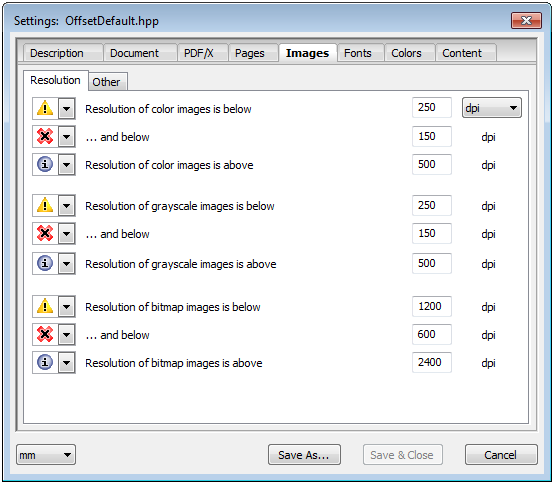

These are rules referring to the images or bitmaps (1-bit images or image mask operators) contained in the page contents. Respective error messages always refer to page objects.
The following tabs are found:
This is where you set check criteria that check the properties of images or bitmaps that are found in the page contents of the PDF documents.
Resolution of color images is below... and below...
The check criterion is met if there are color images whose resolution is less than the set value.
The "... and below" setting is enabled if "Continue with warning" is set as the preflight action.
You can set a second check with this setting. When you enter a second, lower resolution and set the preflight action to "Cancel with error", processing aborts and an error message is issued if there are images whose resolution is less than this second value.
Resolution of color images is above
The check criterion is met if there are color images whose resolution is more than the set value.
Resolution of grayscale images is below/... and below/Resolution of grayscale images is above
The settings for grayscale images are equivalent to the settings for color images (see the "Resolution of color images is below" parameter).
Resolution of bitmap images is below/... and below/Resolution of bitmap images is above
The settings for bitmap images are the same as those for color images (see "Resolution of color images is below").
Images using lossy JPEG compression are present
Compression of JPEG images always involves a loss of data. JPEG 2000 supports both lossless and lossy compression. This check criterion is met if there are images in a lossy JPEG compression.
1-, 2- or 4-bit images are present
PDF allows images with 1, 2, 4, 8 or 16 bit per pixel and color channel. 8-bit images are usual.
16-bit images are present
16-bit images are supported as of PDF version 1.5.
The PDF/X standard does not permit 16-bit images.
OPI comments are present
In OPI image data inclusion ("Open Prepress Interface"), the documents do not contain high-resolution images but only placeholders and references to the high-resolution images. These references are found as "OPI comments" in the code of the input documents. OPI image data replacement is illegal in a PDF/X workflow.
•Remove
You can remove these OPI comments safely only if you do not wish to use OPI image data inclusion and you are sure that all the images are embedded in the PDF documents in the correct resolution.
Images with alternate image are present
This checks whether the documents already have alternate images that are used for a fast view.
•Remove
It is a good idea to enable automatic creation of alternate images in the Preflighter, and for that reason you should also enable "Remove". If you don't, alternate images are created only for those images that do not yet have any alternate images.
The PDF/X standard allows alternate images.
Alternate image is default for printing
If your PDF document has one or more alternate images, you can set one alternate image to be the default for printing. In this case, this alternate image is printed. Generally, this alternative image is different to what you see in the document on the screen.
•Change
You should enable "Change" to avoid any issues that may occur in this context.
Alternate images as a default for printing are prohibited in PDF/X.
Not enough image data
An image that is defined among other things by height, width and color space always has an exact number of bytes. Missing image data normally is due to an error in the generation of the PDF.

|
Note: This check is time-consuming because each image must be fully read in. |
Indexed images are present
Some applications have problems with the further processing of indexed images. Indexed images have as many as 256 different color values that are taken from a table.
HD Privacy Statement | Imprint | Prinect Know How